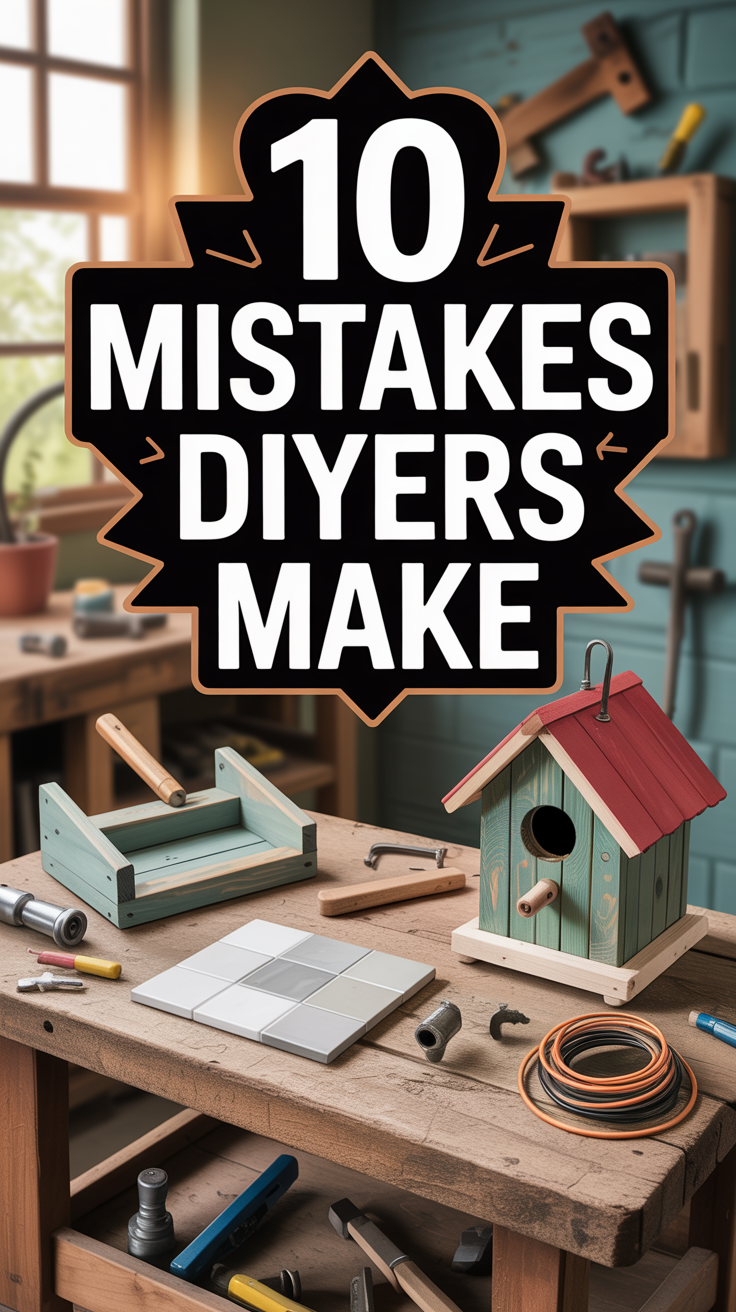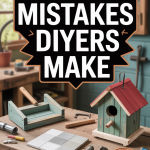10 Mistakes DIYers Make
There’s something deeply satisfying about completing a home improvement project with your own two hands. The sense of accomplishment, the money saved, and the personal touch you can add to your living space make DIY projects incredibly appealing to millions of homeowners. From simple weekend tasks like painting a room to more ambitious undertakings like kitchen renovations, the DIY movement has transformed how we approach home improvement.
However, the path from enthusiastic beginner to skilled DIYer is often paved with costly mistakes, frustrating setbacks, and occasionally dangerous situations. While making mistakes is part of the learning process, some errors can be expensive, time-consuming, or even hazardous. The good news is that most DIY disasters are entirely preventable with proper planning, realistic expectations, and a willingness to learn from others’ experiences.
Whether you’re a complete novice picking up your first hammer or a seasoned weekend warrior looking to refine your approach, understanding these common pitfalls can save you time, money, and considerable frustration. Let’s explore the ten most frequent mistakes DIYers make and, more importantly, how to avoid them.
1. Skipping the Planning Phase
Perhaps the most fundamental mistake DIYers make is diving headfirst into a project without adequate planning. The excitement of starting something new can be intoxicating, but failing to plan properly is like building a house without a foundation – everything that follows becomes unstable.
Proper planning involves several critical steps that many enthusiasts overlook. First, accurate measurements are absolutely essential. The old carpenter’s adage “measure twice, cut once” exists for good reason. A single measurement error can cascade into multiple problems, requiring expensive materials to be reordered and significant time to be lost. Take the time to measure every dimension multiple times, and don’t forget to account for things like baseboards, trim, and irregular walls that might affect your project.
Creating detailed plans and drawings, even for seemingly simple projects, helps you visualize the end result and identify potential problems before they become expensive mistakes. This doesn’t mean you need architectural blueprints for hanging shelves, but sketching out your project with dimensions and noting the sequence of steps can prevent many headaches later.
Time estimation is another area where planning falls short. Most DIYers dramatically underestimate how long projects will take, often by a factor of two or three. This leads to rushed work, shortcuts, and frustration when the weekend project stretches into weeks. Be realistic about your skill level and available time, and always add a buffer for unexpected complications – because there will be unexpected complications.
Material estimation requires similar attention to detail. Running out of paint, tiles, or lumber mid-project not only delays completion but can also result in color or batch mismatches that are impossible to hide. Calculate your material needs carefully, add 10-15% for waste and mistakes, and keep receipts for returns if you overestimate.

2. Using the Wrong Tools
The temptation to make do with whatever tools you have on hand is understandable, especially when starting out in DIY. However, using inappropriate tools is not just inefficient – it can be dangerous and often produces poor results that require expensive corrections.
Many DIYers fall into the trap of thinking they can accomplish any task with a basic toolkit consisting of a hammer, screwdriver, and maybe a drill. While these tools are certainly useful, they’re insufficient for most projects beyond the most basic repairs. Trying to cut precise angles with a hand saw when you need a miter saw, or attempting to drive screws into hard materials with a manual screwdriver instead of a proper drill, will result in frustration, fatigue, and subpar results.
The key is understanding that quality tools are an investment, not an expense. A good circular saw, for instance, will last for decades and produce clean, accurate cuts that make your projects look professional. Cheap tools, on the other hand, often break at crucial moments, produce poor results, and can even be dangerous to use.
This doesn’t mean you need to buy the most expensive tools available, but it does mean researching what tools are actually required for your project and investing in decent quality versions. Consider that the cost of quality tools is often less than the cost of fixing mistakes made with inadequate equipment.
For expensive tools you’ll rarely use, consider renting rather than buying. Most home improvement stores offer tool rental services, and the cost of renting a specialized tool for a weekend is often less than buying a cheap version that won’t perform well.
Safety is another crucial consideration when it comes to tools. Using tools for purposes they weren’t designed for, or using damaged tools, significantly increases the risk of injury. A dull saw blade, for instance, requires more force to cut and is more likely to bind or kick back, potentially causing serious injury.
3. Ignoring Safety Precautions
Safety might not be the most exciting aspect of DIY projects, but it’s arguably the most important. Every year, thousands of DIYers end up in emergency rooms due to preventable accidents that occurred because basic safety precautions were ignored or overlooked.
The most common safety oversight is failing to wear appropriate protective equipment. Safety glasses, hearing protection, dust masks, and work gloves might seem unnecessary for “quick” tasks, but accidents happen in an instant. A single wood chip in the eye or a moment of inattention with a power tool can result in permanent injury that no amount of money can undo.
Different projects require different safety considerations. Working with chemicals like paint strippers or adhesives requires proper ventilation and sometimes respiratory protection. Electrical work demands understanding of circuit breakers and the proper use of voltage testers. Plumbing projects might involve exposure to harmful bacteria or dangerous gases.
Many DIYers also make the mistake of working alone on potentially dangerous tasks. Having someone nearby when using power tools, working at heights, or dealing with heavy materials isn’t just helpful – it can be lifesaving if something goes wrong. This person doesn’t need to be actively helping with the project, but they should be aware of what you’re doing and able to respond in an emergency.
Research is a crucial component of safety that’s often overlooked. Before starting any project, especially one involving unfamiliar tools or techniques, take time to understand the potential hazards and proper safety procedures. YouTube videos, manufacturer instructions, and safety guides are readily available and can prevent serious accidents.
Finally, know your limits. If a project involves working with gas lines, major electrical work, or structural modifications, it may be time to call a professional. The cost of hiring an expert is minimal compared to the potential cost of a serious accident or major structural damage.
4. Underestimating Costs
One of the most common reasons DIY projects turn into sources of stress rather than satisfaction is poor financial planning. Many enthusiasts focus only on the obvious costs – materials and basic tools – while overlooking the numerous hidden expenses that can quickly double or triple a project’s budget.
The most significant oversight is failing to budget for mistakes. Even experienced DIYers make errors that require additional materials, and beginners should expect to make several. That beautiful hardwood flooring you calculated perfectly might need an extra box when you discover you cut several pieces incorrectly. The paint you measured precisely might require additional gallons when you realize the walls need an extra coat for proper coverage.
Quality versus cost is another area where DIYers often make expensive mistakes. The temptation to save money by buying the cheapest materials available is strong, but this approach frequently backfires. Cheap paint requires more coats and doesn’t last as long. Inexpensive tools break at crucial moments. Low-grade lumber warps and splits. In many cases, buying quality materials upfront costs less than replacing cheap materials that fail prematurely.
Hidden costs are everywhere in DIY projects. That simple bathroom renovation might require updating plumbing that doesn’t meet current codes. The kitchen backsplash project could reveal electrical issues that need addressing. Removing old flooring might uncover subfloor damage that requires repair. These discoveries aren’t necessarily signs of poor planning – they’re normal parts of working with older homes – but they need to be anticipated financially.
Tool costs can also spiral beyond initial expectations. While you might start a project thinking you only need a few basic tools, you often discover that specialized tools would make the job significantly easier, faster, or more professional-looking. The cost of these additional tools should be factored into your project budget from the beginning.
Consider also the cost of your time. While DIY projects can save money compared to hiring professionals, they also require significant time investment. If a project takes much longer than anticipated, the opportunity cost of that time might exceed the savings from doing it yourself.
5. Not Getting Proper Permits
The permit process might seem like bureaucratic red tape, but building permits exist for important safety and legal reasons. Skipping required permits is a mistake that can have serious long-term consequences, even if the project itself is completed successfully.
Many DIYers don’t realize which projects require permits. While hanging pictures or painting rooms obviously don’t need official approval, the line isn’t always clear. Electrical work, plumbing modifications, structural changes, and additions typically require permits, but so do some projects that might seem minor, like replacing windows or installing a ceiling fan.
The permit process serves several important functions. First, it ensures that work meets current building codes, which exist to protect safety and ensure proper construction techniques. Second, it creates a paper trail that can be crucial when selling your home. Third, it often includes inspections that can catch potentially dangerous mistakes before they become serious problems.
Working without permits when they’re required can create significant problems down the road. Insurance companies might refuse to cover damage related to unpermitted work. When selling your home, buyers might demand that unpermitted work be brought up to code or removed entirely, which can be expensive and time-consuming. In some cases, you might be required to tear out completed work so that inspectors can verify that it was done correctly.
The permit process also provides access to professional expertise. Building inspectors have seen countless projects and can often spot potential problems that inexperienced DIYers might miss. Their feedback, while sometimes frustrating, can prevent serious mistakes and improve the quality of your work.
Research permit requirements early in your planning process. Contact your local building department to understand what’s required for your specific project. The cost and time investment of getting proper permits is almost always less than the cost of dealing with problems later.

6. Overestimating Skills
Confidence is essential for successful DIY projects, but overconfidence can be dangerous and expensive. Many DIYers tackle projects that are beyond their current skill level, leading to poor results, safety hazards, and often the need to hire professionals to fix mistakes – which typically costs more than hiring professionals from the beginning.
The learning curve for different DIY skills varies dramatically. Painting a room is relatively forgiving – mistakes can usually be corrected with minimal cost or effort. Electrical work, on the other hand, has little margin for error and mistakes can be deadly. Understanding where your skills fit on this spectrum is crucial for project selection.
Social media and DIY television shows contribute to this problem by making complex projects look deceptively simple. A thirty-minute television segment or a time-lapse video doesn’t show the years of experience, specialized tools, and careful preparation that go into professional-quality work. What looks easy on screen might require skills that take months or years to develop.
Electrical and plumbing work deserve special mention because mistakes in these areas can be particularly dangerous and expensive. Incorrect electrical work can cause fires or electrocution. Plumbing mistakes can lead to water damage, mold growth, and structural problems. While some basic electrical and plumbing tasks are within the reach of careful DIYers, major work in these areas is best left to licensed professionals.
The key is honest self-assessment. Start with simpler projects and gradually work up to more complex ones as your skills develop. There’s no shame in recognizing that a particular project is beyond your current abilities – in fact, this recognition demonstrates wisdom and maturity.
Consider taking classes or workshops to develop new skills before tackling challenging projects. Many community colleges, home improvement stores, and trade organizations offer hands-on training that can significantly improve your capabilities and confidence.
7. Rushing the Job
Impatience is perhaps the most common enemy of quality DIY work. The desire to see quick results, combined with the reality that most projects take longer than expected, creates pressure to cut corners and skip important steps. This rush to completion almost invariably leads to poor results and often requires expensive corrections.
Many steps in DIY projects simply cannot be rushed. Paint needs time to dry between coats. Adhesives require proper curing time. Concrete must set according to manufacturer specifications. Attempting to speed up these processes by applying heat, skipping waiting periods, or moving to the next step prematurely often ruins the entire project.
The “good enough” mentality is another manifestation of impatience that leads to poor results. When you’re tired, frustrated, or running out of time, it’s tempting to accept work that’s “close enough” rather than taking the time to do it right. However, these compromises are usually obvious in the finished project and often become sources of ongoing frustration.
Quality work requires attention to detail, and attention to detail requires time. Professional contractors understand this, which is why they often seem to work more slowly than eager DIYers expect. They know that taking time to do each step properly results in better outcomes and fewer callbacks to fix problems.
Planning realistic timelines is crucial for avoiding the rush trap. Most DIY projects take significantly longer than initially estimated, especially for beginners. Build buffer time into your schedule, and be prepared to extend deadlines rather than compromising quality.
Sometimes the best decision is to stop work and resume later when you have adequate time to complete the job properly. A project that sits unfinished for a week is better than a project that’s completed poorly due to time pressure.
8. Poor Material Selection
Choosing the right materials for your project is crucial for both immediate success and long-term satisfaction. Many DIYers make material selection decisions based primarily on cost or appearance, without considering factors like durability, compatibility, and environmental suitability. These oversights can lead to premature failure, ongoing maintenance problems, and the need for expensive replacements.
Compatibility issues are among the most common material selection mistakes. Not all materials work well together, and some combinations can actually cause damage over time. For example, using certain types of metal fasteners with pressure-treated lumber can lead to corrosion problems. Mixing different types of wood stains or paints can result in poor adhesion and uneven finishes. Combining materials with different expansion rates can cause cracking and separation.
Environmental factors play a crucial role in material selection but are often overlooked by enthusiastic DIYers. Materials that work perfectly in one climate might fail quickly in another. Wood species that resist humidity in some regions might warp or rot in others. Exterior paints formulated for mild climates might not withstand harsh winters or intense sun exposure.
The temptation to prioritize style over function is particularly strong in DIY projects, especially those involving visible elements like flooring, countertops, or fixtures. While aesthetics are certainly important, choosing materials based solely on appearance without considering practical factors like durability, maintenance requirements, and suitability for the intended use often leads to disappointment.
Research is essential for good material selection. Read manufacturer specifications, understand warranty terms, and look for materials that are specifically designed for your intended application. Online reviews from other DIYers can provide valuable insights into how materials perform in real-world conditions.
Consider the total cost of ownership, not just the initial purchase price. A more expensive material that lasts longer and requires less maintenance might be more economical over time than a cheaper alternative that needs frequent replacement or repair.
9. Inadequate Preparation
Surface preparation is often the least exciting part of any DIY project, but it’s frequently the most important factor in determining the final result. Many DIYers, eager to get to the “fun” parts of their projects, rush through or skip preparation steps entirely. This impatience almost always shows in the finished work and can significantly reduce the lifespan of the project.
Cleaning and preparing surfaces properly is essential for good adhesion of paints, stains, adhesives, and other finishes. Dirt, grease, old paint, and other contaminants prevent new materials from bonding properly, leading to peeling, flaking, and premature failure. What might seem like adequate cleaning to an untrained eye often isn’t sufficient for professional-quality results.
Primer and base coats serve important functions beyond just providing a foundation for finish coats. They seal surfaces, provide uniform color bases, and improve adhesion. Skipping these steps to save time or money almost always results in poor coverage, uneven color, and reduced durability. The cost of primer is minimal compared to the cost of redoing work that fails prematurely.
Environmental conditions during preparation and application significantly affect results but are often ignored by DIYers eager to complete their projects. Temperature, humidity, air circulation, and dust levels all impact how materials cure and perform. Working in less-than-ideal conditions often requires adjusting techniques, extending drying times, or postponing work entirely.
Surface defects like holes, cracks, and uneven areas need to be addressed before applying finishes. These imperfections won’t be hidden by paint or other coatings – they’ll often become more noticeable. Taking time to fill holes, sand rough spots, and create smooth, even surfaces is essential for professional-looking results.
The preparation phase is also the best time to protect surrounding areas from damage. Proper masking, drop cloths, and protective coverings prevent accidental damage to floors, furniture, and fixtures. The time spent on protection is minimal compared to the time and cost of repairing accidental damage.
10. Failing to Learn from Mistakes
Perhaps the most limiting mistake DIYers make is failing to learn from their errors and experiences. Every project, whether successful or not, provides valuable lessons that can improve future work. DIYers who don’t take time to reflect on what went well and what could be improved are doomed to repeat the same mistakes repeatedly.
Documentation is a powerful learning tool that most DIYers overlook. Keeping notes about what worked, what didn’t, and what you would do differently next time creates a valuable reference for future projects. Photos of work in progress can help you remember techniques that worked well or identify problems that weren’t apparent at the time.
Many DIYers view mistakes as failures rather than learning opportunities. This perspective prevents growth and improvement. Professional tradespeople understand that mistakes are part of the learning process and use them to refine their techniques and avoid similar problems in the future.
Seeking feedback and advice is another area where many DIYers fall short. Pride or embarrassment might prevent asking for help, but experienced DIYers, professionals, and online communities are often willing to share knowledge and advice. Learning from others’ experiences is much less expensive than learning from your own mistakes.
Continuing education through books, videos, classes, and workshops can significantly improve DIY skills and reduce the likelihood of costly mistakes. The investment in learning is almost always less than the cost of fixing problems caused by lack of knowledge.
Finally, knowing when to ask for help or hire professionals is itself a valuable skill. Recognizing the limits of your abilities and seeking appropriate assistance when needed isn’t a sign of failure – it’s a sign of wisdom and maturity.
DIY Mistakes and You
DIY projects can be incredibly rewarding, providing a sense of accomplishment, cost savings, and the satisfaction of improving your living space with your own hands. However, success in DIY work requires more than enthusiasm and basic tools. It demands careful planning, realistic assessment of skills and resources, attention to safety, and a commitment to quality work.
The ten mistakes outlined in this article represent the most common pitfalls that can turn enjoyable projects into expensive disasters. By understanding these potential problems and taking steps to avoid them, you can significantly improve your chances of DIY success.
Remember that becoming skilled at DIY work is a journey, not a destination. Start with simpler projects and gradually work up to more complex ones as your skills and confidence develop. Don’t be afraid to ask for help, seek additional training, or hire professionals when projects exceed your current abilities.
Most importantly, approach each project with patience, preparation, and realistic expectations. The goal isn’t to complete projects as quickly as possible, but to complete them safely and to a standard you’ll be proud of for years to come. With proper planning, the right tools, adequate preparation, and a commitment to learning from experience, your DIY projects can provide years of satisfaction and value to your home.
The key to successful DIY work lies not in avoiding all mistakes – that’s impossible – but in learning from them, planning carefully, and approaching each project with the respect it deserves. Whether you’re hanging a picture or renovating a kitchen, these principles will serve you well and help ensure that your DIY adventures are both safe and successful.




